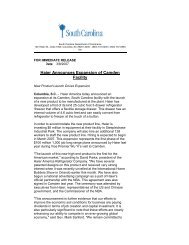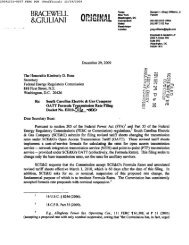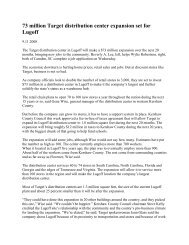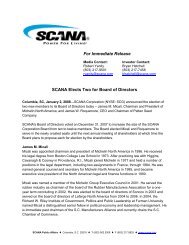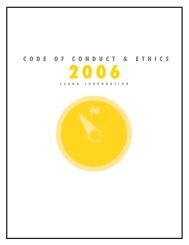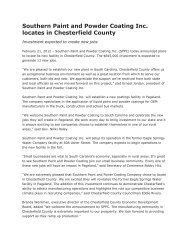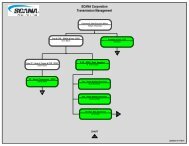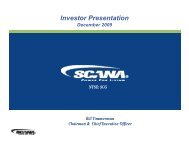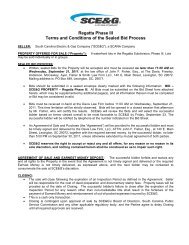10-K - SCANA Corporation
10-K - SCANA Corporation
10-K - SCANA Corporation
You also want an ePaper? Increase the reach of your titles
YUMPU automatically turns print PDFs into web optimized ePapers that Google loves.
Table of Contents<br />
6. DERIVATIVE FINANCIAL INSTRUMENTS<br />
Consolidated SCE&G recognizes all derivative instruments as either assets or liabilities in the statement of financial position<br />
and measures those instruments at fair value. Consolidated SCE&G recognizes changes in the fair value of derivative instruments<br />
either in earnings or within regulatory assets or regulatory liabilities, depending upon the intended use of the derivative and the<br />
resulting designation. The fair value of derivative instruments is determined by reference to quoted market prices of listed contracts,<br />
published quotations or, for interest rate swaps, discounted cash flow models with independently sourced data.<br />
Policies and procedures and risk limits are established to control the level of market, credit, liquidity and operational and<br />
administrative risks assumed by Consolidated SCE&G. <strong>SCANA</strong>’s Board of Directors has delegated to a Risk Management Committee<br />
the authority to set risk limits, establish policies and procedures for risk management and measurement, and oversee and review the<br />
risk management process and infrastructure for <strong>SCANA</strong> and each of its subsidiaries, including Consolidated SCE&G. The Risk<br />
Management Committee, which is comprised of certain officers, including the Consolidated SCE&G’s Risk Management Officer and<br />
senior officers, apprises the Board of Directors with regard to the management of risk and brings to the Board’s attention any areas of<br />
concern. Written policies define the physical and financial transactions that are approved, as well as the authorization requirements<br />
and limits for transactions.<br />
Commodity Derivatives<br />
SCE&G uses derivative instruments to hedge forward purchases and sales of natural gas, which create market risks of<br />
different types. Instruments designated as cash flow hedges are used to hedge risks associated with fixed price obligations in a volatile<br />
market and risks associated with price differentials at different delivery locations. The basic types of financial instruments utilized are<br />
exchange-traded instruments, such as NYMEX futures contracts or options, and over-the-counter instruments such as options and<br />
swaps, which are typically offered by energy and financial institutions. Cash settlement of commodity derivatives are classified as an<br />
operating activity in the consolidated statements of cash flows.<br />
SCE&G’s tariffs include a PGA that provides for the recovery of actual gas costs incurred. The SCPSC has ruled that the<br />
results of these hedging activities are to be included in the PGA. As such, the cost of derivatives and gains and losses on such<br />
derivatives utilized to hedge gas purchasing activities are recoverable through the weighted average cost of gas calculation. The offset<br />
to the change in fair value of these derivatives is recorded as a regulatory asset or liability. These derivative financial instruments are<br />
not designated as hedges for accounting purposes.<br />
Interest Rate Swaps<br />
Consolidated SCE&G synthetically converts variable rate debt to fixed rate debt using swaps that are designated as cash flow<br />
hedges. Periodic payments to or receipts from swap counterparties related to these derivatives are recorded within interest expense<br />
and are classified as an operating activity for cash flow purposes.<br />
In anticipation of the issuance of debt, Consolidated SCE&G may use treasury rate lock or forward starting swap agreements<br />
that are designated as cash flow hedges. The effective portions of changes in fair value and payments made or received upon<br />
termination of such agreements are recorded in regulatory assets or regulatory liabilities. Such amounts are amortized to interest<br />
expense over the term of the underlying debt. Ineffective portions are recognized in income. Cash payments made or received upon<br />
termination of these financial instruments are classified as an investing activity in the consolidated statements of cash flows.<br />
The effective portion of settlement payments made or received upon termination are amortized to interest expense over the<br />
term of the underlying debt and are classified as a financing activity in the consolidated statements of cash flows.<br />
Quantitative Disclosures Related to Derivatives<br />
SCE&G was party to natural gas derivative contracts for 2,490,000 DT and 2,460,000 DT at December 31, 2011 and 20<strong>10</strong>,<br />
respectively. Consolidated SCE&G was a party to interest rate swaps designated as cash flow hedges with aggregate notional amounts<br />
of $471.4 million and $421.4 million at December 31, 2011 and 20<strong>10</strong>, respectively.<br />
126



